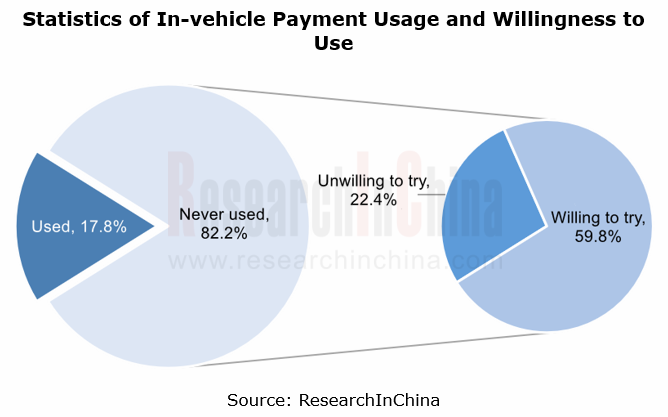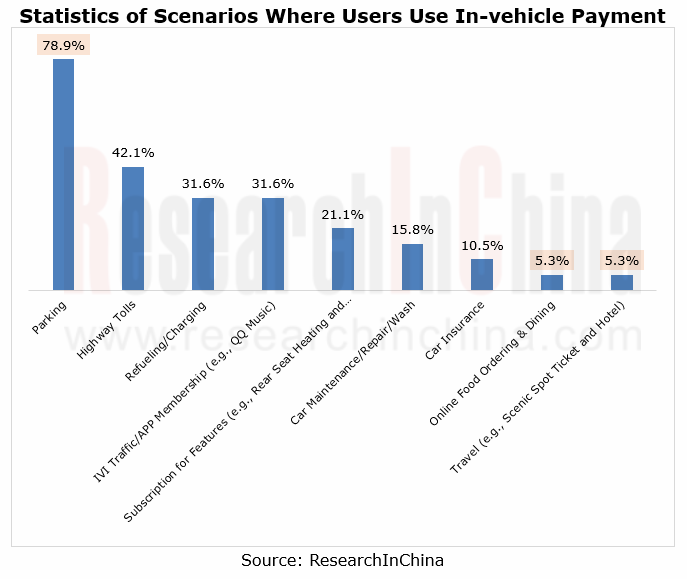China In-Vehicle Payment Market Research Report, 2023 released by ResearchInChina analyzes and researches the status quo of China's in-vehicle payment market, components of the industry chain, layout of OEMs and payment platforms, consumer survey, and development trends.
①The market demand for in-vehicle payment is rising.
In-vehicle payment refers to the function allowing for payment through in-vehicle communication (e.g., SIM card and WiFi) and IVI system. In-vehicle payment enables car owners to pay for services such as parking, refueling, food ordering and shopping without getting off the car, bringing far more convenient and better experience to users.
According to the survey by ResearchInChina, there are a relatively small number of people using in-car payment at this stage, making up only 17.8% of the total samples. Yet users' willingness to use this function is very high. 72.7% of the consumers who have not used in-car payment yet, or 59.8% of the total samples say they are "willing to try in-car payment".

At present, users use in-car payment in such scenarios as parking, highway pass, refueling/charging, and purchasing IVI traffic and APP membership. Of the users who have used in-car payment:
- Up to 78.9% use in-car payment for parking;
- 42.1% use in-car payment for highway tolls;
- In-vehicle payment is also often used to pay for refueling/charging fees (31.6%), IVI traffic and APP membership (31.6%), feature subscription (21.1%), car maintenance/repair/wash (15.8%), and car insurance (10.5%);
- Fewer users use this function in the scenarios of online food ordering and dining (5.3%) and travel (5.3%).

②The in-vehicle payment industry chain is taking shape.
In terms of supply chain, in-vehicle payment involves two major segments: in-vehicle payment device and in-vehicle payment platform.
In-vehicle payment devices are led by communication devices (SIM card, communication module and T-Box), interaction devices (touch/voice/ face/gesture/fingerprint interaction), and authentication devices (security chip); in-vehicle payment platforms are primarily cloud platform, payment platform, IVI system, ecosystem service platform, ecosystem service provider, and OEM.
As companies in each industry chain segment worked to make layout in recent years, the in-vehicle payment market has kept growing, with the following two major features.
1. In-vehicle payment is available to more scenarios.
Foreign automakers including BMW, Mercedes-Benz, Honda and Hyundai, and Chinese automakers such as Great Wall Motor, Xpeng Motors, Geely, Chery and AITO have launched their in-car payment function. They have widely deployed this function in parking, refueling/charging and food ordering scenarios, and are also applying it on a small scale in car wash/maintenance/repair services, feature subscription, ticket booking and other scenarios.
For example, in October 2022, BMW added the BMW ConnectedDrive Store to its IVI system via OTA updates. It enables in-car payment for subscriptions, and 13 features such as front seat heating, steering wheel heating and Carplay through the IVI system.
2. Multimodal interaction is being added to in-vehicle payment.
At present, the most common in-car payment is scan to pay and password-free payment. As in-car multimodal interaction technology improves, face recognition, fingerprint recognition and voice recognition are becoming the new in-car payment interaction and authentication methods.
For example, Mercedes-Benz has added fingerprint recognition and authentication to its latest in-car payment system PAY+; Chery EXEED TX/TXL supports face verification payment, a function allowing users to pay for parking fees or shopping through face recognition. The addition of multimodal interaction makes in-vehicle payment more secure and convenient.

3. The ecosystem is a key factor affecting in-car payment.
In the mobile payment system, millions of iOS and Android developers have developed various applications and built very rich application ecosystems, meeting living, work and entertainment needs of consumers and making smartphones an indispensable terminal in users' life.
In the in-car payment system, financial institutions like China UnionPay and VISA have developed a series of in-car payment systems; Alipay, Banma Zhixing and Huawei among others have built a variety of vehicle ecosystem platforms and launched a range of in-car services covering parking, refueling, travel, shopping and other scenarios.
Compared with mobile payment, the in-vehicle payment ecosystem is still weak at this stage, only meeting the payment needs in specific scenarios. With the development of intelligent cockpit and high-level autonomous driving, drivers will be freed from driving tasks in specific scenarios and pay more attention to other in-car needs. At this time, creating an in-car living space and building a closed-loop ecosystem with payment as the entrance will become a big demand.
Autonomous Driving Domain Controller and Central Computing Unit (CCU) Industry Report, 2025
Research on Autonomous Driving Domain Controllers: Monthly Penetration Rate Exceeded 30% for the First Time, and 700T+ Ultrahigh-compute Domain Controller Products Are Rapidly Installed in Vehicles
L...
China Automotive Lighting and Ambient Lighting System Research Report, 2025
Automotive Lighting System Research: In 2025H1, Autonomous Driving System (ADS) Marker Lamps Saw an 11-Fold Year-on-Year Growth and the Installation Rate of Automotive LED Lighting Approached 90...
Ecological Domain and Automotive Hardware Expansion Research Report, 2025
ResearchInChina has released the Ecological Domain and Automotive Hardware Expansion Research Report, 2025, which delves into the application of various automotive extended hardware, supplier ecologic...
Automotive Seating Innovation Technology Trend Research Report, 2025
Automotive Seating Research: With Popularization of Comfort Functions, How to Properly "Stack Functions" for Seating?
This report studies the status quo of seating technologies and functions in aspe...
Research Report on Chinese Suppliers’ Overseas Layout of Intelligent Driving, 2025
Research on Overseas Layout of Intelligent Driving: There Are Multiple Challenges in Overseas Layout, and Light-Asset Cooperation with Foreign Suppliers Emerges as the Optimal Solution at Present
20...
High-Voltage Power Supply in New Energy Vehicle (BMS, BDU, Relay, Integrated Battery Box) Research Report, 2025
The high-voltage power supply system is a core component of new energy vehicles. The battery pack serves as the central energy source, with the capacity of power battery affecting the vehicle's range,...
Automotive Radio Frequency System-on-Chip (RF SoC) and Module Research Report, 2025
Automotive RF SoC Research: The Pace of Introducing "Nerve Endings" such as UWB, NTN Satellite Communication, NearLink, and WIFI into Intelligent Vehicles Quickens
RF SoC (Radio Frequency Syst...
Automotive Power Management ICs and Signal Chain Chips Industry Research Report, 2025
Analog chips are used to process continuous analog signals from the natural world, such as light, sound, electricity/magnetism, position/speed/acceleration, and temperature. They are mainly composed o...
Global and China Electronic Rearview Mirror Industry Report, 2025
Based on the installation location, electronic rearview mirrors can be divided into electronic interior rearview mirrors (i.e., streaming media rearview mirrors) and electronic exterior rearview mirro...
Intelligent Cockpit Tier 1 Supplier Research Report, 2025 (Chinese Companies)
Intelligent Cockpit Tier1 Suppliers Research: Emerging AI Cockpit Products Fuel Layout of Full-Scenario Cockpit Ecosystem
This report mainly analyzes the current layout, innovative products, and deve...
Next-generation Central and Zonal Communication Network Topology and Chip Industry Research Report, 2025
The automotive E/E architecture is evolving towards a "central computing + zonal control" architecture, where the central computing platform is responsible for high-computing-power tasks, and zonal co...
Vehicle-road-cloud Integration and C-V2X Industry Research Report, 2025
Vehicle-side C-V2X Application Scenarios: Transition from R16 to R17, Providing a Communication Base for High-level Autonomous Driving, with the C-V2X On-board Explosion Period Approaching
In 2024, t...
Intelligent Cockpit Patent Analysis Report, 2025
Patent Trend: Three Major Directions of Intelligent Cockpits in 2025
This report explores the development trends of cutting-edge intelligent cockpits from the perspective of patents. The research sco...
Smart Car Information Security (Cybersecurity and Data Security) Research Report, 2025
Research on Automotive Information Security: AI Fusion Intelligent Protection and Ecological Collaboration Ensure Cybersecurity and Data Security
At present, what are the security risks faced by inte...
New Energy Vehicle 800-1000V High-Voltage Architecture and Supply Chain Research Report, 2025
Research on 800-1000V Architecture: to be installed in over 7 million vehicles in 2030, marking the arrival of the era of full-domain high voltage and megawatt supercharging.
In 2025, the 800-1000V h...
Foreign Tier 1 ADAS Suppliers Industry Research Report 2025
Research on Overseas Tier 1 ADAS Suppliers: Three Paths for Foreign Enterprises to Transfer to NOA
Foreign Tier 1 ADAS suppliers are obviously lagging behind in the field of NOA.
In 2024, Aptiv (2.6...
VLA Large Model Applications in Automotive and Robotics Research Report, 2025
ResearchInChina releases "VLA Large Model Applications in Automotive and Robotics Research Report, 2025": The report summarizes and analyzes the technical origin, development stages, application cases...
OEMs’ Next-generation In-vehicle Infotainment (IVI) System Trends Report, 2025
ResearchInChina releases the "OEMs’ Next-generation In-vehicle Infotainment (IVI) System Trends Report, 2025", which sorts out iterative development context of mainstream automakers in terms of infota...